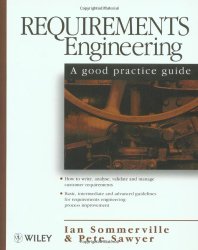Engineering Bookshelf
- Aerospace
- Biological
- Civil
- Chemical
- Environmental
- Electrical
- Materials
- Mechanical
- Petroleum
- Geoengineering
- Software

Requirements Engineering: A Good Practice Guide
by Ian Sommerville, Pete SawyerPublisher: Wiley
ISBN: 0471974447
Check price @ amazon.com , amazon.ca , amazon.co.uk
Book Description
Requirements engineering is the process of discovering, documenting and managing the requirements for a computer-based system. The goal of requirements engineering is to produce a set of system requirements which, as far as possible, is complete, consistent, relevant and reflects what the customer actually wants. Although this ideal is probably unattainable, the use of a systematic approach based on engineering principles leads to better requirements than the informal approach which is still commonly used. This book presents a set of guidelines which reflect the best practice in requirements engineering.
Based on the authors' experience in research and in software and systems development, these guidelines explain in an easy-to-understand way how you can improve your requirements engineering processes. The guidelines are applicable for any type of application and, in general, apply to both systems and software engineering. The guidelines here range from simple 'common sense' to those which propose the introduction of complex new methods. The guidelines and process improvement schemes have been organised so that you can pick and choose according to your problems, goals and available budget. There are few dependencies between guidelines so you can introduce them in any order in your organisation. Guidelines presented in the book
- are consistent with ISO 9000 and CMM
- are ranked with cost/benefit analysis
- give implementation advice
- can be combined and applied to suit your organisation's needs
- are supported by a web page pointing to RE tools and resources
Customer Reviews
By Christophe Addinquy
I found this book very insightfull, but it needs to have a first idea about what is the requirements engineering and how it's processed. Once you have this idea, this book helps you. You'll find here, essentially pieces of advices which looks like process patterns (in my opinion it should even improve the book to show these advices through a pattern form) to tackle specific problems whith requirements engineering. Moreover, these advices can be read separately. For the beginners, it mises a strong frame along the book to know what is exactly requirements management and so on. But I think the authors are right to do not try to satisfy everybody. As a weakness, I don't know why, but this book seems to be a bit old, where the edition date is only 1997, through a lot of details I feel to read a book written in the early 1980s. But this book is not about technology, so it's not a big weakness.
By Doug Childs (dchilds@mediaone.net)
I've been in this part of the business for a while and I haven't seen anything quite like this book for requirements. A nice blend of theory and VERY practical advice, you can easily use the book in at several ways: 1. Better understanding of a particular techniques' effectiveness and context, for example use cases (called viewpoints here) or state-transition diagrams. 2. Flip through the book and see which guidelines you can most effectively apply to your current project, e.g. building a database or putting in a table of contents. 3. Evaluate your "maturity level" & determine how to improve your current requirements process.
I can't tell if would be helpful to someone who had never wrestled with serious requirements, but even then, it has a good bibliography & website.
Belongs on the analyst's working bookshelf.